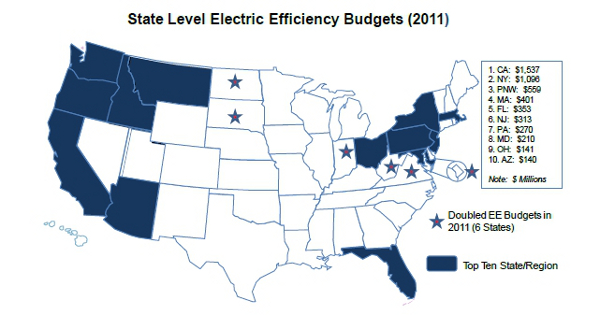January 22, 2012


As the economy shows signs of moving in the right direction, so does our personal and national energy consumption. A growing number of energy efficiency programs are noticeably increasing our energy savings and our usage efficiency. According to a new report from the Institute for Electricity Efficiency (IEE), in 2010, our overall national energy efficiency programs saved enough electricity to power almost 10 million homes. That almost 112 million megawatt-hours (MWh) of electricity was a 21 percent increase over 2009 levels. (Image courtesy of The Edison Foundation)
[nggallery id=100 template=carousel images=4][imagebrowser id=100] By Debra Atlas
As the economy shows signs of moving in the right direction, so too does our personal and national energy consumption. A growing number of energy efficiency programs are noticeably increasing our energy savings and our usage efficiency.
According to a new report from The Institute for Electricity Efficiency (IEE), in 2010, our national energy programs saved enough electricity to power almost 10 million homes. Those 112 million megawatt-hours (MWh) of electricity equaled a 21 percent increase over 2009 levels.
“The growth in electric utility expenditures for energy efficiency is the major reason behind [this growth],” said IEE Executive Director Lisa Wood.
Energy efficiency spending took a leap forward in 2010. Nationally we spent $2.8 billion, which was a 28 percent increase from the year before. And ten states which consume almost 22 percent of all the electricity in the United States and account for 74 percent of all U.S. electric efficiency budgets doubled their expenditures between 2009 and 2011. The fact that these states doubled their energy efficiency budgets has a wide impact on the long-term demand for electricity.
And the news looks brighter for this year, with Indiana, North Dakota, South Dakota, Virginia, West Virginia and Washington D.C. more than doubling their 2010 surveyed budgets for energy efficiency expenditures. The brightest spot is that many of these states rely on coal as a primary source of energy. Increasing their energy efficiency budgets can help these states reduce their carbon footprints.
Thirty-seven states increased their 2011 energy efficiency budgets. The overall increase in 2011 state budgets relative to the year before was a 25 percent increase.
“We believe that total U.S. ratepayer-funded budgets for electric efficiency will easily exceed $12 billion by 2020,” said Wood.
There’s a growing range of options and incentives for consumers and for small and large businesses to save energy, ranging from the federal, state and local levels. Some of these stem from funding from the American Recovery and Reinvestment Act of 2009 (ARRA / the economic stimulus bill). These include:
A new report from the American Council for an Energy-Efficient Economy (ACEEE) also advocates that we pay attention to large-scale energy savings that could cut overall U.S. energy consumption over 50 percent. This could save consumers more than $300 to $400 billion per year and add almost two million jobs by 2050.
At Sierra Club Green Home, we know it’s important to recognize our progress, and these figures are definitely encouraging. The more consumers and businesses opt-in to energy efficiency, the more energy savings and less CO2 we can all share.
For related article, see: 15 Tips to Save a Watt and a Buck
Check out more articles by Debra Atlas.
© 2012 SCGH, LLC.
]]>